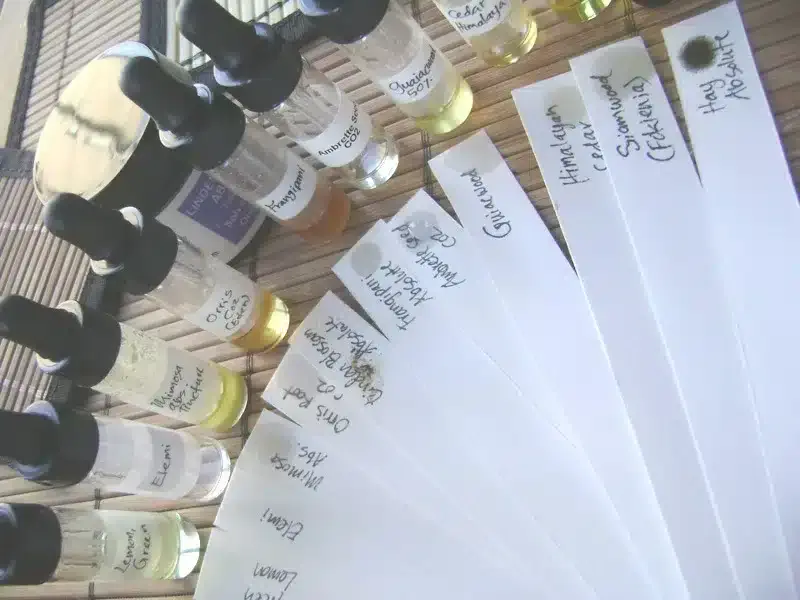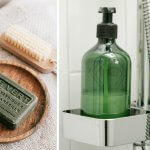
Last December, a creative colleague, already known for her soapmaking skills, presented me with a bottle of homemade cologne.
Expecting the sort of patchouli-dominant odor common among hippies back when I was a kid, I tentatively squirted a little onto my wrist. Surprisingly, it was the kind of fresh, outdoor fragrance that I happen to like. Something I’d actually wear.
Deciding this would make an interesting topic for my blog, I persuaded my colleague to show me how it’s done. If you’re looking for a rewarding, no-mess hobby or pursuit that takes up little time, this could be it.
In this post, I’ll explain how to make both fragrance oils and alcohol-based colognes (eau de toilette, eau de cologne, and aftershave).
The four simple but masculine fragrances below, which I’m calling woody, distinctive, tangy, and fresh, are composed of therapeutic-grade essential oils and other ingredients you can trust. That means no synthetic aroma, no artificial color, and no denatured alcohol.
The best thing is, you can adjust them according to your preferences, creating your very own niche fragrance.
What You Need to Create Your Own Cologne
- A glass jar with a lid for mixing and maturing alcohol-based fragrances. Before use, clean with detergent, rinse, and allow to dry. As an extra measure, give it a final rinse with rectified spirit.
- An 80 to 100 mL spray bottle with which to apply alcohol-based fragrances. Clean as above, and don’t worry if it’s less than elaborate; think of the simple packaging and presentation of CK One and Acqua di Parma.
- A 15 to 25 mL dropper bottle for fragrance oil.
- A small funnel. It should fit the opening of your bottle.
- Essential oils according to the recipes listed below. To avoid allergies and irritations, it’s advisable to use therapeutic-grade oils, which are available at pharmacies.
- Extra pipettes for testing and adding glycerin.
- Blotting strips for testing.
- To make fragrance oil, you’ll need 10 mL of jojoba oil per fragrance. Jojoba oil has a neutral aroma and is suitable for all skin types.
- For alcohol-based colognes, you’ll need rectified spirit and distilled water. Rectified spirit is 190-proof ethanol distilled several times for extreme purity. It’s sometimes labeled “neutral spirits” and is available in the U.S. as a product called Everclear.
- Cosmetic-grade glycerin (optional) for alcohol-based colognes: this emulsifies and blends the oil and water; keeps the product clear and attractive; prevents evaporation so as the fragrance lasts longer after applying; and adds an oily texture for a better skin feel.

How to Make Fragrance Oil
Fragrance oil is more intense and longer-lasting than alcohol-based cologne.
Only the tiniest amount applied with a pipette on your pulse points is enough for it to be noticeable.
I’ll begin with this product since it requires only essential oils and jojoba, thus giving you a good sense of how fragrances are assembled.
But your first project should be an alcohol-based cologne, for which I’ll provide instructions later in this post. Due to their larger volume, these allow more scope for adjustment.
Add Essential Oils According to their Notes
The ingredients in the following recipes are listed in the exact order they should be added. Always start with the jojoba oil, then add the essential oils in order of their notes: first the base notes, then the heart notes, and lastly the headnotes.
Shake after adding each oil.
In case you’re wondering how notes work, the aroma you notice immediately after applying a fragrance is the headnote (also called the top note). After 15–30 minutes, the heart note (also called the middle note) becomes noticeable. The base note emerges about half an hour later and lingers long after the head and heart notes have faded.
Maturing Your Fragrance
Before using your fragrance oil, leave it in a cool, dark place to mature for at least two weeks or up to three months. This allows the individual aromas to blend into a balanced fragrance.
Due to its smaller quantity, I recommend mixing and maturing fragrance oil in a dropper bottle.
Woody Fragrance
| Ingredients |
|---|
| 10 mL jojoba Oil |
| 2 drops vetiver |
| 1 drop oak moss |
| 1 drop vanilla |
| 1 drop orange |
| 2 drops lime |
Distinctive Fragrance
| Ingredients |
|---|
| 10 mL jojoba |
| 3 drops cedarwood |
| 2 drops hyssop |
| 2 drops myrtle |
| 3 drops petitgrain |
| 4 drops lemon |
Tangy Fragrance
| Ingredients |
|---|
| 10 mL jojoba oil |
| 2 drops Swiss stone pine |
| 2 drops verbena |
| 5 drops grapefruit |
| 1 drop ginger |
| 1 drop neroli |
| 2 drops bergamot |
| 1 drop lemongrass |
Fresh Fragrance
| Ingredients |
|---|
| 10 mL jojoba oil |
| 1 drop cedarwood |
| 3 drop grapefruit |
| 1 drop lavender |
| 1 drop European silver fir |
| 2 drop myrtle |
How to Make Alcohol-Based Cologne
To make eau de toilette, eau de cologne, and aftershave, use the above fragrance oil recipes but replace jojoba oil with rectified spirit. This allows for better solubility of the essential oils than water alone and acts as a preservative.
Mix the alcohol and essential oils in a jar, adding water and glycerin after the fragrance has matured.
The more water you add, the milder the finished product will be.
Swirl the jar before transferring to a spray bottle.
How to Make Eau de Toilette
For 60 mL of eau de toilette, you’ll need 20 mL of rectified spirit and 40 mL of water. Start with the spirit, then add the essential oils in the same order as for the fragrance oil recipes above. Multiply the oil quantities in each recipe by six to every 60 mL of spirit/water.
Example: Fresh Recipe
- 20 mL rectified spirit
- 12 drops cedarwood
- 12 drops grapefruit
- 12 drops lavender
- 6 drops European silver fir
- 6 drops myrtle
- 40 mL water
- 5 drops glycerin
As with fragrance oil, shake the jar after adding each essential oil.
How to Make Eau de Cologne
Eau de cologne contains fewer aromatic compounds than eau de toilette, which means its fragrance will be less intense and won’t last as long on the skin.
Make it the same way as you would an eau de toilette, but multiply the essential oil quantities by three to every 60 mL of spirit and water instead of six.
How to Make Aftershave
For a mild aftershave, use 30 mL of rectified spirit and 50 mL of water. There is no need to multiply the essential oil quantities in the above recipes.

Testing and Adjusting Your Cologne
If it’s a recipe you haven’t tried before, test every 48 hours and adjust according to your preferences. For this, use a pipette and blotting strips.
This is how it’s done:
Taking the “fresh” recipe above as an example, if after 48 hours you think you’d prefer less grapefruit, add one more drop of each of the other oils and wait a further 48 hours. If you think you’d like more lavender, add another drop of that oil. Continue in this way until you achieve the scent you desire.
To ensure you can create the same fragrance again, keep a note of every adjustment.
I find aftershave to be the safest product for experimentation. Once I’ve finished adjusting, it can turn out as intense as an eau de toilette.
If you’d like to create something similar to a commercial fragrance you enjoy, look up the basenotes.com directory, where you’ll find the ingredients of many well-known brands.
© 2025 J. Richardson
Related Posts
Disclaimer
The information provided by The Neat and Tidy Man (“we,” “us,” or “our”) on theneatandtidyman.com (the “site”) is for general informational purposes only. While we endeavor to keep the information up to date and correct, we make no representation or warranty of any kind, express or implied, regarding the completeness, accuracy, reliability, suitability, adequacy, validity, or availability of any information on the site. Under no circumstance shall we have any liability to you for any loss or damage of any kind incurred as a result of the use of the site or reliance on any information provided on the site. Your use of the site and your reliance on any information on the site is solely at your own risk.



